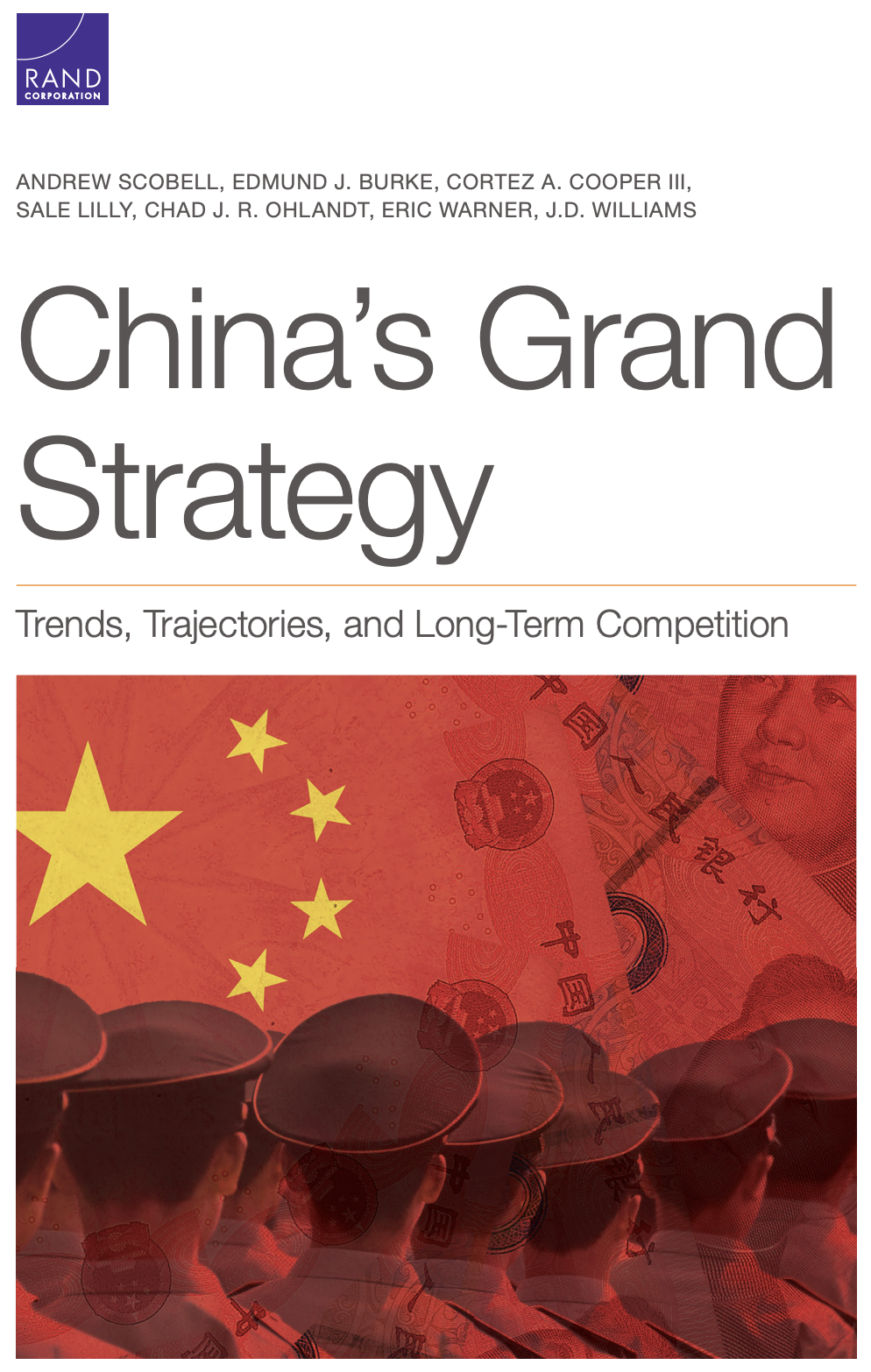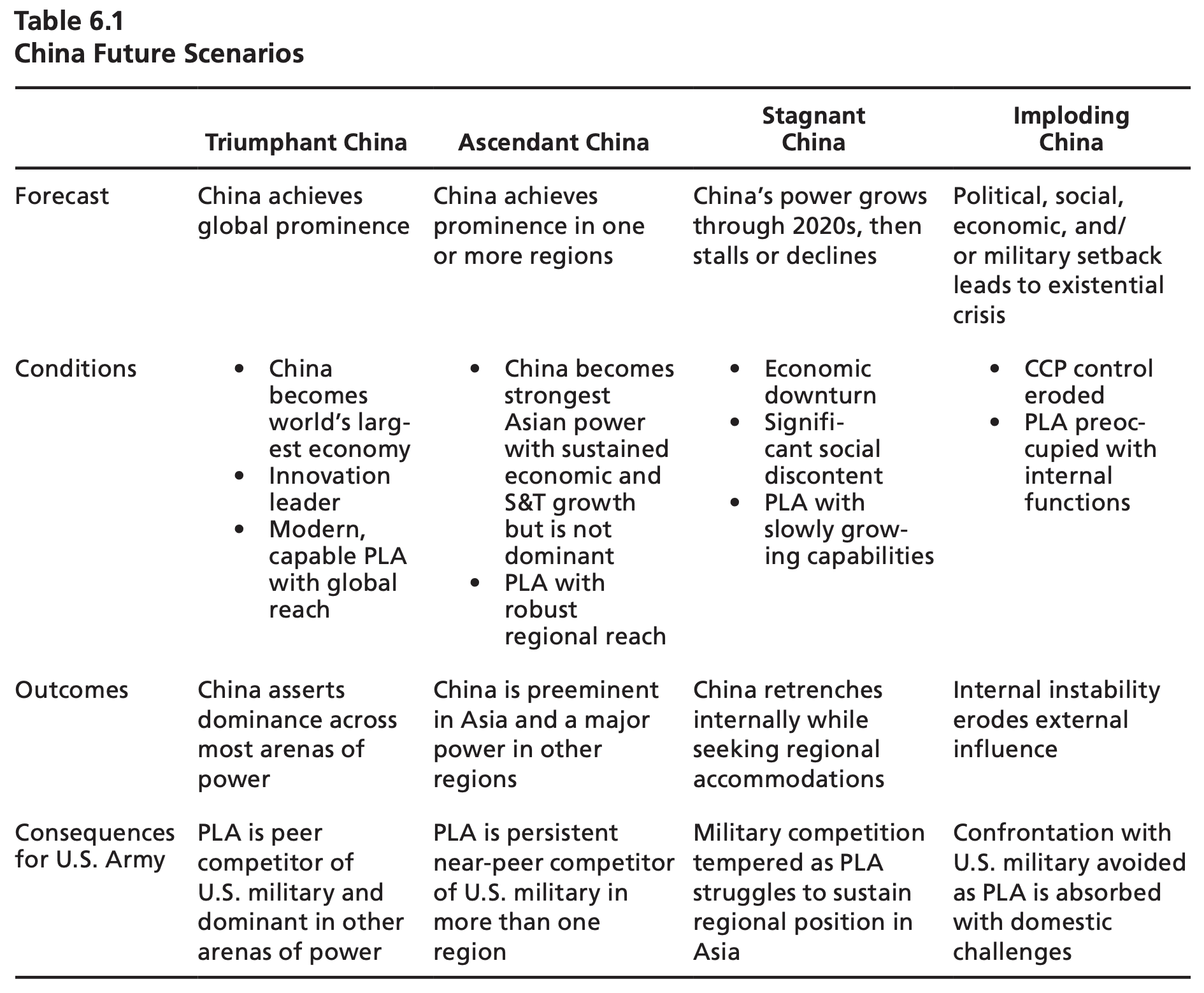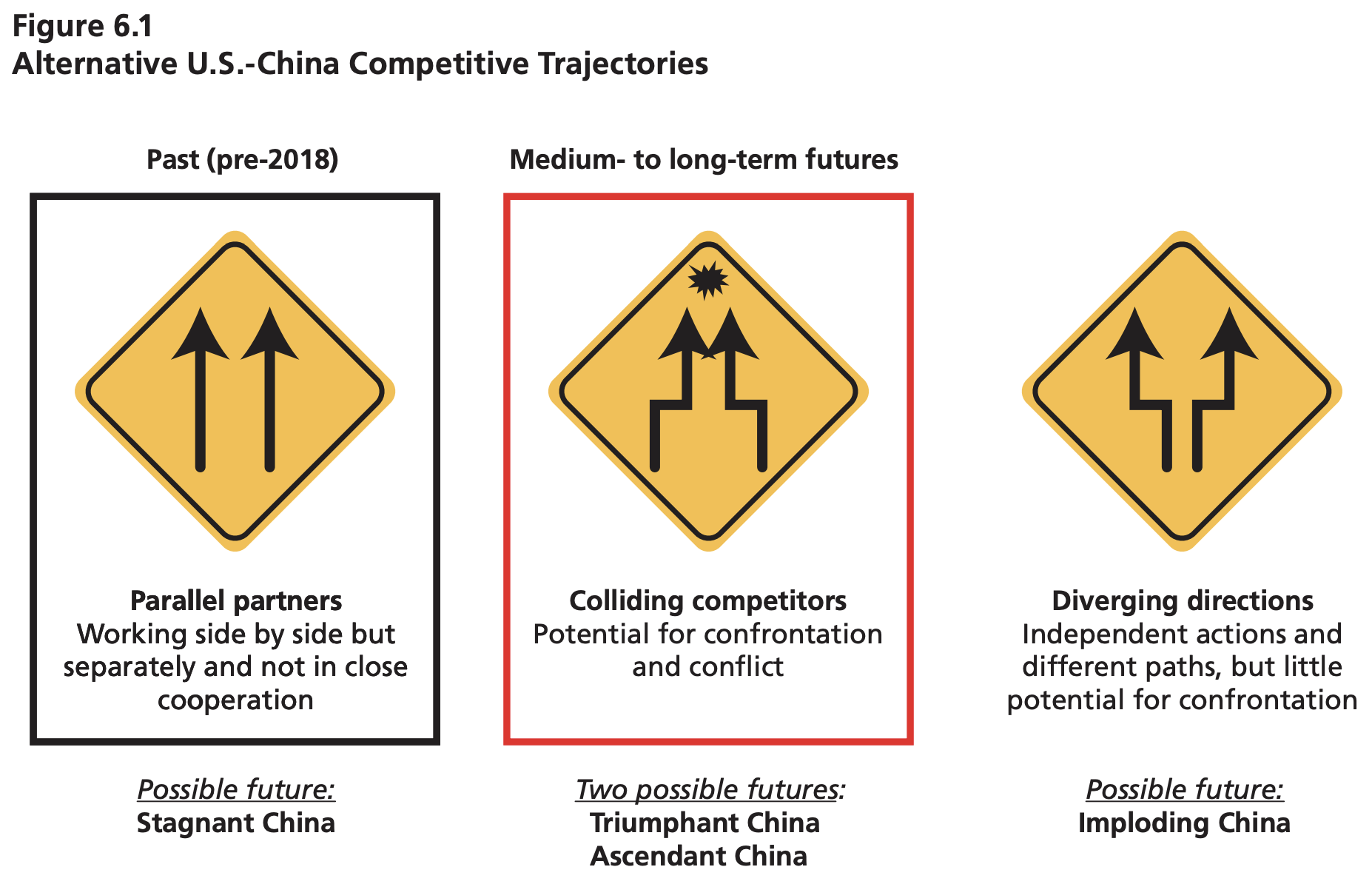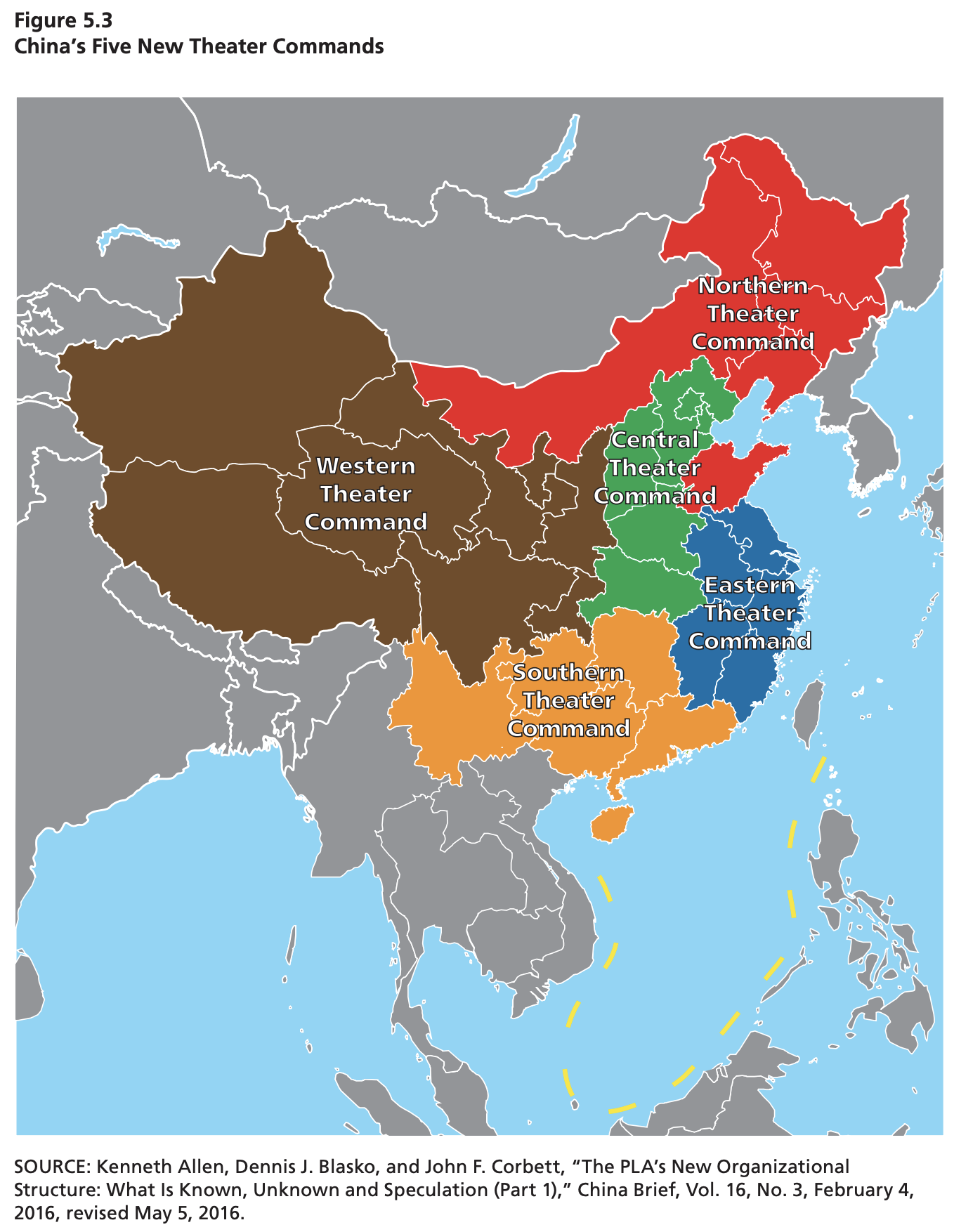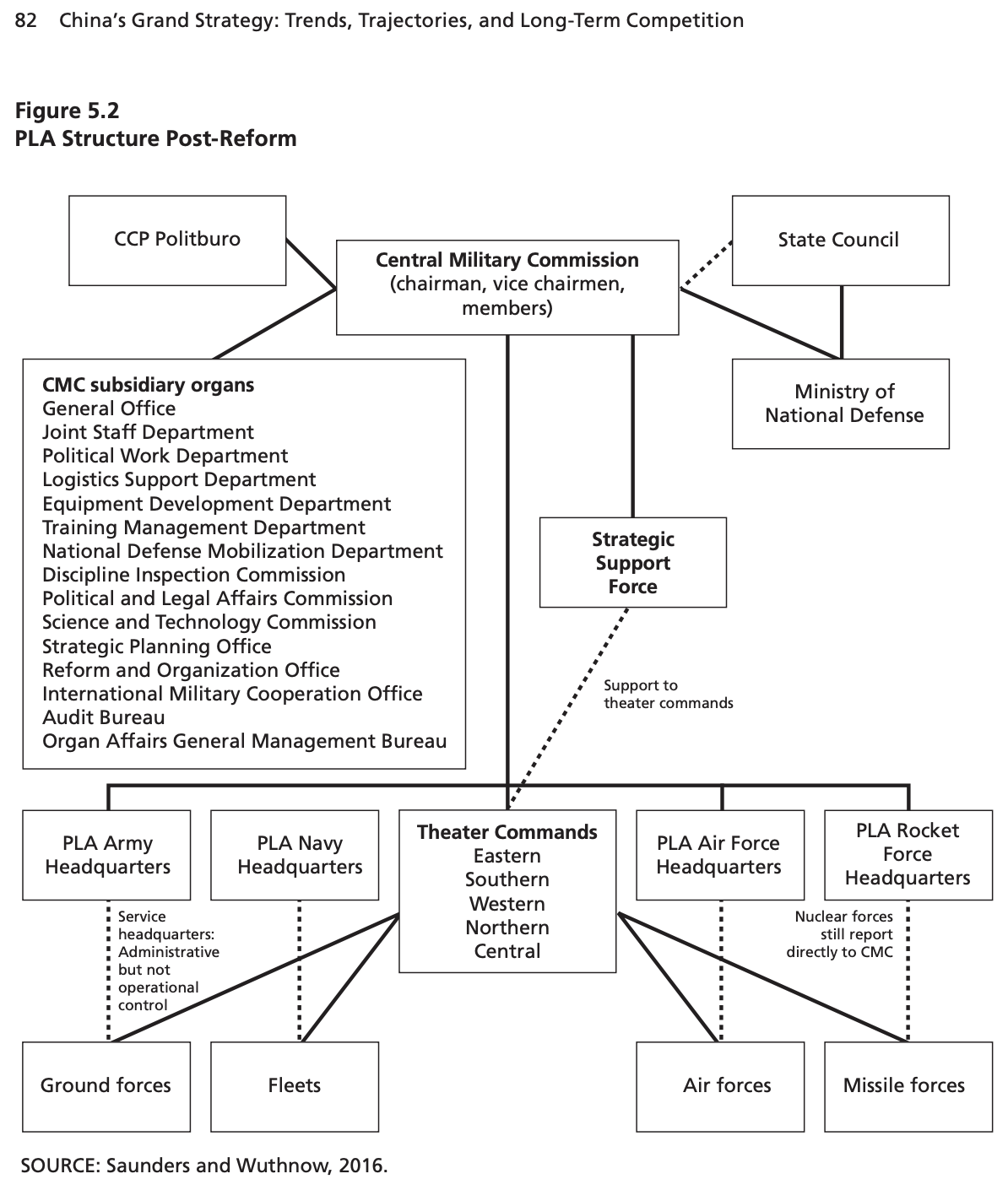China’s Grand Strategy: Trends, Trajectories, and Long-Term Competition
Andrew Scobell, Edmund J. Burke, Cortez A. Cooper III, Sale Lilly, Chad J. R. Ohlandt, Eric Warner, and J.D. Williams, China’s Grand Strategy: Trends, Trajectories, and Long-Term Competition (Santa Monica, CA: RAND, 2020).
Click here to read a press release.
To explore what extended competition between the United States and China might entail out to 2050, the authors identified and characterized China’s grand strategy, analyzed its component national strategies (diplomacy, economics, science and technology, and military affairs), and assessed how successful China might be at implementing these over the next three decades. China’s central goals are to produce a China that is well governed, socially stable, economically prosperous, technologically advanced, and militarily powerful by 2050.
China has delineated specific objectives regarding economic growth, regional and global leadership in evolving economic and security architectures, and control over claimed territory. In several cases, these objectives bring China into competition, crisis, and even potential conflict with the United States and its allies. China’s leaders clearly recognize this and have delineated and prioritized specific actors and actions as threats to the achievement of these objectives. With the United States, China seeks to manage the relationship, gain competitive advantage, and resolve threats emanating from that competition without derailing other strategic objectives (particularly those in the economic realm).
Preparing for a triumphant or ascending China seems most prudent for the United States because these scenarios align with current national development trends and represent the most-challenging future scenarios for the U.S. military. In both scenarios, the U.S. military should anticipate increased risk to already threatened forward-based forces in Japan, South Korea, and the Philippines and a loss of the ability to operate routinely in the air and sea space above and in the Western Pacific.
Key Findings
Any one of the four scenarios analyzed—triumphant China, ascendant China, stagnant China, or imploding China—is possible three decades hence
- A triumphant China is least likely because such an outcome presumes little margin for error and the absence of any major crisis or serious setback between now and 2050.
- An imploding China is not likely because, to date, Chinese leaders have proved skilled at organizing and planning, adept at surmounting crises, and deft at adapting and adjusting to changing conditions.
- By 2050, China most likely will have experienced some mixture of successes and failures, and the most plausible scenarios would be an ascendant Chinaor a stagnant China. In the former scenario, China will be largely successful in achieving its long-term goals, while, in the latter scenario, China will confront major challenges and will be mostly unsuccessful in implementing its grand strategy.
These four scenarios could produce any one of three potential trajectories in U.S.-China relations: parallel partners, colliding competitors, or diverging directions
- The parallel partners trajectory is a continuation of the state of U.S.-China relations in 2018. This trajectory is most likely to occur with a stagnant China and probably an ascending China.
- The colliding competitors trajectory is most likely to manifest in a triumphant China scenario in which Beijing becomes more confident and assertive.
- The diverging directions trajectory is most likely to occur in an imploding China scenario because Beijing will be preoccupied with mounting domestic problems.
Recommendations
- The likely scenarios call for greater attention to improving joint force capabilities and preparing to operate with much longer logistics tails. For the U.S. Army, this means efforts to optimize key units and capabilities for available airlift and sealift to get soldiers to the fight quickly or to a hot spot before the fight breaks out.
- Because China probably will be able to contest all domains of conflict across the broad swath of the region by the mid-2030s, the U.S. Army, as part of the joint force, will need to be able to respond immediately to crises or contingencies at various points of contention. To be inside the wire at the outset of a crisis or conflict will require a combination of forward-based forces, light and mobile expeditionary forces, and interoperable allied forces.
- The U.S. Army and allied forces must also develop and train on concepts to reinforce conventional extended deterrence and keep competition from becoming conflict.
- The ability of highly capable, responsive, and resilient maritime and air forces to quickly and effectively suppress China’s burgeoning reconnaissance-strike system, along with specific special operations and Army capabilities, will largely determine the extent to which China’s leadership remains risk averse when considering military options to resolve regional disputes.
p. ix
Two fundamental questions are at the heart of this report: (1) What will China look like by 2050? (2) What will U.S.-China relations look like by 2050? The answers are provided by analyzing trends in the management of politics and society and studying national-level strategies in diplomacy, economics, S&T, and military affairs. Using these analyses, the report develops a range of possible future scenarios for mid-21st-century China and then generates an accompanying set of potential future trajectories for U.S.-China long-term competition.
Four Scenarios
The four scenarios of what China might look like by 2050 are
p. x
- triumphant China, in which Beijing is remarkably successful in realizing its grand strategy
- ascendant China, in which Beijing is successful in achieving many, but not all, of the goals of its grand strategy
- stagnant China, in which Beijing has failed to achieve its long-term goals
- imploding China, in which Beijing is besieged by a multitude of problems that threaten the existence of the communist regime.
Four elements are analyzed for each scenario:
- the overall forecast for China’s development and ability to achieve its goals
- the specific domestic and foreign conditions required for the scenario to occur
- the outcome of the scenario in terms of China’s influence in the world
- the scenario’s consequences for the United States.
This report concludes that any one of these four scenarios—ranging from stunning success in achieving China’s grand strategy at one extreme to abject failure at the other extreme—is possible three decades hence. But a triumphant China is least likely because such an outcome presumes little margin for error and the absence of any major crisis or serious setback between now and 2050—an implausible assumption. At the other extreme, while an imploding China is conceivable, it is not likely because, to date, Chinese leaders—for the most part—have proved skilled at organizing and planning, adept at surmounting crises, and deft at adapting and adjusting to changing conditions. By 2050, China most likely will have experienced some mixture of successes and failures, and the most plausible scenarios would be an ascendant China or a stagnant China. In the former scenario, China will be largely successful in achieving its long-term goals, while, in the latter scenario, China will confront major challenges and will be mostly unsuccessful in implementing its grand strategy. …
p.xi
… While future U.S.-China cooperation could entail higher levels of cooperation and closer degrees of coordination, improved collaboration in a consistent and across-the-board manner seems unrealistic given the depth of mutual distrust and climate of competition. In the security realm, for example, the United States and China have both worked to address nontraditional security threats. This has included such efforts as counterpiracy patrols in the Gulf of Aden and extracting weapons of mass destruction from Syria. The parallel partners trajectory is most likely to occur with a stagnant China and probably an ascending China—at least with respect to out-of-area operations. The second trajectory, colliding competitors, envisions a more competitive and contentious relationship. This trajectory is most likely to manifest in a triumphant China scenario in which Beijing becomes more confident and assertive. As the People’s Liberation Army (PLA) is bolder and more energetic in seeking to expel U.S. military forces from the Western Pacific (or elsewhere), the potential for confrontation and conflict increases. The third trajectory, diverging directions, assumes that the two countries will neither be actively cooperating nor in direct conflict. This trajectory is most likely to occur in an imploding China scenario because Beijing will be preoccupied with mounting domestic problems.
p. 24
Leadership and System
While China’s political system is regularly identified as a party-state, there are actually three distinct major bureaucratic structures—a communist party founded in 1921, an armed force officially founded in 1927, and a state administrative structure formally established in 1949. Thus, it is more accurate to describe the regime in tripartite terms as a party-military-state.3 Xi Jinping and his colleagues are members of the “fifth generation” of CCP-PLA-PRC leaders—a new breed of Chinese communist elites born in the 1950s and coming of age in the Cultural Revolution (1966–1976).4
Unlike the first and second generations, they are not veteran revolutionaries—those led by Long Marchers Mao Zedong and Deng Xiaoping, respectively—with decades of military experience and agrarian political struggle prior to the founding of the PRC. Unlike the third and fourth generations, born in the 1930s and 1940s, respectively, the fifth generation of leaders is not dominated by engineers, such as Jiang Zemin and Hu Jintao. …
… in the lineup of the 18th Politburo, announced in November 2012, engineers and scientists (seven) were outnumbered by social science and humanities majors (ten). Of these ten members, three had studied economics, two had studied history, two had studied Chinese literature, one had studied law, another had studied philosophy, and one had studied international politics. Of the seven scientists, two had majored in engineering, and five had studied other STEM subjects.5 These education trends were even more pronounced among the 25 members of the 19th Politburo, named in October 2017. Engineers and scientists (six) were greatly outnumbered by
p. 25
CCP leaders who had studied social sciences and humanities (16).6 Of the 16, eight had studied politics, international relations, political economy, or philosophy; four had majored in Chinese language and literature; two had studied economics; one had studied law; and another had studied history. In comparison, only four Politburo members had studied engineering, one had studied pharmacy, and another had studied agriculture. Moreover, the 19th Politburo contains a smattering of worldly members—individuals with significant international exposure, including foreign degrees or some coursework at overseas institutions of higher education. At least one member speaks fluent English, and another speaks fluent French.
Engineers tend to focus on concrete measures of hard power and be less concerned with softer and more abstract dimensions of national power. The 18th Politburo actually had the smallest proportion of engineering majors as members in three decades—22 percent—whereas previous politburos were dominated by engineers, who made up at least 62 percent and up to 90 percent of the group.7 The 19th Politburo has even fewer engineers—only 16 percent.8
Ambitious Alarmists
We label this generation of Chinese leaders “smart power nationalists” because Xi and his fellow fifth-generation leaders recognize that in the 21st century, while economic heft and military might be important for China, for the ruling party-military-state to maintain a firm grip on power, it cannot afford to ignore the promotion of lofty principles and big ideas. Particularly during the post-Mao era (i.e., since 1977), the CCP emphasized political pragmatism and material incentives, focusing on building China’s hard power, starting with the economy and then turning to national defense. By the early 2000s, the regime had begun to pay greater attention to the potency of attraction. For fifth-generation leaders, the importance of soft power is two-sided: on the one hand, strengthening legitimacy of the CCP-PLA-PRC by playing up nationalist goals, patriotic achievements, and Chinese values, while, on the other hand, counteracting dangerous Western ideas, such as democracy, human rights, and freedom of religion. Fortifying the former is considered essential to successfully combatting the latter. A more ominous extension of this is the expanded use of influence operations or political warfare beyond China’s borders (see Chapter Four).
The most obvious manifestation of this greater attention to soft power is Xi’s articulation of the China Dream. The intent is to capture the imagination of the Chinese people by offering a vision of a prosperous and promising future for the country. Unlike the American Dream, which is more about individual opportunity to attain
p. 26
greater material wealth through determination and hard work, the Chinese version is about collective achievement and national glory. In other words, the China Dream is about the concrete achievement of “national rejuvenation” under the wise and farsighted direction of CCP-PLA-PRC leaders. Indeed, the China Dream is intended to inspire the Chinese people, similar to the way that candidate Donald Trump’s slogan to “make America great again” seemed to resonate with sizeable segments of the American electorate during the 2016 presidential election campaign. …
Standard analyses of China’s political system matter-of-factly opine that the highest priority of Xi and his fellow Politburo members is “regime survival.” But this terminology can be very misleading: The word survival implies that Chinese leaders believe that they are in dire straits and are living in daily fear of imminent regime collapse or overthrow. Quite to the contrary: Chinese leaders are confident enough to believe that the CCP’s hold on power is secure for the near term and likely to endure through the medium term.9 However, because there are no absolute guarantees in politics and statecraft, constant vigilance is required. This is why the regime employs a highly sophisticated, robust, and costly coercive apparatus to protect its hold on political power. Nevertheless, Chinese leaders are preoccupied with maintaining domestic stability and tend to be ultra-sensitive to the prospect of chaos. Interestingly, this alarmism is a trait that regime elites share with ordinary Chinese citizens.10
Thus, Chinese leaders are not living from day to day, from week to week, or even from month to month. Rather, party, military, and state elites plan well ahead in five-year and ten-year increments, and they anticipate that the regime will be around to celebrate the centenaries of the founding of the CCP in 2021, the PLA in 2027, and the PRC in 2049. Consequently, far from being desperate or limited in their goals, these leaders exude supreme confidence and articulate highly ambitious agendas, despite regular bouts of alarmism.11
Yet, this pervasive regime insecurity has a subtle but discernible impact on Chinese statecraft: It injects a wariness and suspicion that pervades Beijing’s interactions with other capitals and a reluctance to commit major resources to projects beyond China’s borders. Domestically, regime insecurity produces initiatives to concentrate power, undermine perceived adversaries, and pander to key constituencies, such as the PLA, and other elements of the coercive apparatus. Fundamentally, regime leaders
p. 27
are consumed with maintaining stability at home, which prompts streams of material rewards and jingoism combined with calculated intimidation reinforced by cold coercion. The ultimate irony of the regime presiding over the “people’s republic” is that its greatest fear is that one day it will have to confront the wrath of the Chinese people directly. Thus, worrying about internal challenges is “what keeps Chinese leaders awake at night.”12
When Xi and other PRC leaders look out from the office windows in their leadership compound of Zhongnanhai, they see the world in terms of four concentric circles, or rings, of insecurity.13 The first and innermost ring is the homeland, extending from the streets of Beijing out toward the boundaries of all the territory controlled or claimed by the PRC. This is, by far, the most important and sensitive ring: Chinese leaders are the most worried about domestic instability. In their eyes, national security begins at home, and regime security is synonymous with national security. The second ring encompasses the areas around the immediate periphery of the PRC, including 14 adjacent countries and the Near Seas, a belt of territory that is also very sensitive to Beijing. The former includes five countries with which China has fought wars over the past 75 years and a good number of fragile and unstable states. The latter encompasses a maritime zone including the East China Sea, the Yellow Sea, the Taiwan Strait, and the South China Sea. A third ring encompasses the entire Asia-Pacific region— Northeast Asia, Southeast Asia, Oceania, South Asia, and Central Asia. The wider neighborhood, while less sensitive than the homeland and periphery, is still viewed as China’s legitimate sphere of influence in which Beijing can rightfully deny or restrict access to external powers. The fourth ring includes the rest of the world beyond the Asia-Pacific. While this outermost ring constitutes the least important ring to Chinese rulers, it is nevertheless a location of growing importance given Beijing’s expanding overseas interests as far afield as the Middle East and the Americas—where China’s greatest rival is located. From Beijing’s perspective, what is particularly significant is that the United States is the one country uniquely capable of threatening China’s interests in all four of these rings.
The Great Restructurer
…Xi appears intent on vigorously shaking up the system. Xi has launched a dizzying array of near-simultaneous policy initiatives, including reorganizations of bureaucratic structures, which, if fully implemented, could significantly alter the ways China formulates and implements foreign
p. 28
and domestic policies. …Xi has emphasized the concentration of political authority in his person over the collective leadership model that has characterized Chinese elite politics since the 1980s.
…Xi’s efforts to date seem best described as “restructuring.” Rather than thoroughly reforming China’s political, military, or economic systems, Xi has actively engaged in revamping these institutions in ways that he believes strengthen both his own power and bolsters the regime’s robustness and resiliency. Consequently, although Xi “accepts the necessity of economic reforms,” for example, “he is much more personally engaged with . . . making China a great power and himself a great leader,” according to one prominent U.S. analyst.14 Of particular note is Xi’s decision in 2013 to establish a National Security Commission. Reportedly modeled after the National Security Council in the United States, the entity is intended to improve coordination between different bureaucratic actors and concentrate greater power in Xi’s own hands. One key difference from the U.S. case is the distinctly domestic security orientation of the Chinese body, which reflects the regime security priorities of top leaders.15
To this end, Xi and his close-knit circle of trusted advisors and subordinates appear to be playing proactive defense at home and vigorous offense abroad. Domestically, they have been busy “cleaning house” by targeting corrupt officials and undermining rival factions in the process. Around China’s immediate periphery they are actively engaged in strengthening China’s territorial claims, especially in the maritime realm, and particularly in the South China Sea. This includes efforts to improve bureaucratic coordination by consolidating maritime law enforcement agencies. Further afield, PRC leaders are launching new initiatives or doubling down on existing efforts: One of the highest-profile initiatives is the Belt and Road Initiative (BRI; see Chapter Four).
p. 31
Xi’s focus next turns to doing everything in his power to ensure that the 100th anniversary of the founding of the CCP is celebrated in appropriate fashion in July 2021. To be considered a successful bash, it must be especially grandiose, both in terms of the visual spectacle and in actual accomplishments. If there are no further shocks to China’s economy, expect a gradual loosening of controls over Chinese land, capital, and energy. If China does experience an economic crisis, expect further state intervention in markets.
Planning and preparations for prior events, such as the September 2015 national holiday and spit-and-polish military parade marking the victory over Japan, will pale in comparison. The event will require a massive and sustained mobilization of resources and personnel not undertaken in China since the 2008 Beijing Olympics. Xi will go to great lengths to avoid disruptions or distractions in terms of preventing potential disturbances by dissidents inside the PRC or persistent tensions beyond its borders. This celebration will be the most significant extravaganza to occur on Xi’s watch, and no effort will be spared to ensure that the centennial events go off without a hitch.
p. 34
…internal stability…is something to which civilian and military authorities pay very close attention. This work is manpower intensive, so millions of monitors and enforcers are employed. This includes not only members of the PRC’s national police force—the Ministry of Public Security—across China but also hundreds of thousands of PAP, agents of the Ministry of State Security, civilian street committees who keep watchful eyes on their residential neighborhoods, and plain-clothed thugs for hire to provide visible day-to-day monitoring of known political dissidents. Moreover, many businesses and bureaucracies maintain their own uniformed security personnel.
In addition, authorities have made greater use of technology to monitor and control the streets and other public spaces in Chinese cities, as well as virtual space. The PRC has one of the most extensive systems of closed-circuit television cameras of any country in the world. Chinese authorities are using the most-modern facial recognition software available to track people. Moreover, the “Great Firewall of China” is very effective in blocking most Chinese citizens from accessing the internet outside of China. The block typically includes the websites of major Western news organizations, such as the New York Times and the Washington Post. But this is not all. Chinese authorities also closely monitor and censor Chinese cyberspace, including blogs and chat rooms, to ensure that most controversial and high-critical coverage on sensitive topics is deleted or buried in strategic distraction.34
The system is quite effective at cracking down on a range of troublemakers— both actual and potential. Known or suspected dissidents are monitored and harassed. Those who persist can be arrested or placed under house arrest. The range of dissidents includes human rights campaigners; religious activists; and those deemed terrorists, separatists, and extremists. Those falling under the latter umbrella category include ethnic Uighur and Tibetan activists, even if these individuals are engaged in peaceful protest or articulating grievances through approved channels. Although extremists have engaged in acts of violence in the PRC, these constitute an extremely small minority. Even ethnic minority figures who have sought to abide scrupulously by Chinese laws and work within prescribed channels have been deemed dangerous. A prime example is Rebiya Kadeer, a highly successful Uighur businesswoman who eventually went into exile.35 Often, such figures are accused of being traitors or foreign spies.
p. 113
The power of the PLA is likely to peak in the 2025 to 2035 time frame. Weapon systems being under development in the late 2010s will be fully operationally capable and deployed throughout the armed forces. Moreover, the benefits of defense reorganization begun in the mid-2010s will begin to be fully realized after ten years. At this time, the PLA will likely be capable of joint operations and expanded power projection inside the Asia-Pacific in an ascendant China scenario and in the wider world in a triumphant China scenario. …

